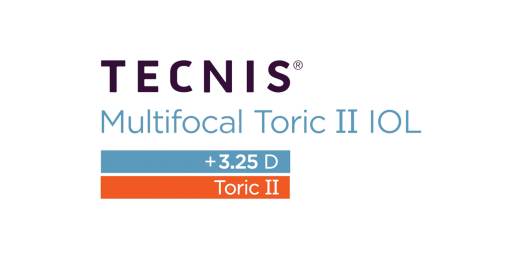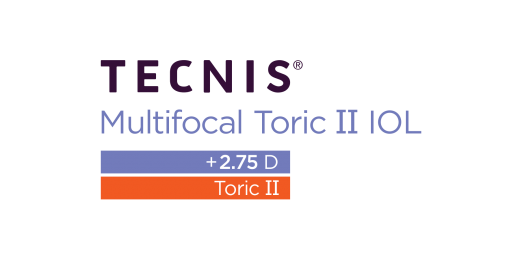Johnson & Johnson Vision Announces U.S. Launch of the TECNIS Multifocal Toric II IOL as the First Multifocal IOL for Cataract Patients with Astigmatism on the New Toric II Platform


- New TECNIS Toric II platform features increased friction on IOL haptics
- Nearly half of all cataract patients have astigmatism,1 yet 49% of surgeons do not attempt to correct significant levels of astigmatism (≥1.0 D) at the time of cataract surgery2
Santa Ana, Calif. May 15, 2020 – Johnson & Johnson Vision*, a global leader in eye health, today announced the U.S. launch of the TECNIS Multifocal Toric II Intraocular Lens (IOL). This is the second IOL product and first multifocal IOL approved on the new TECNIS Toric II platform. The square-edge TECNIS Multifocal Toric II implant features a new generation of frosted haptics, offering more surface texture and friction between the lens haptics and the capsular bag. Haptics serve to securely hold an IOL in the proper position within the eye.3 The new IOLs will be commercially available in May, initially launching in cylinder powers of 1.50, 2.25, 3.00 and 3.75 on the 3.25 D and 2.75 D multifocal add power designs.
Click to Tweet: Designed for patients with presbyopia and astigmatism, @JNJVision announces launch of new multifocal intraocular lens (IOL) on next generation platform to address rotational stability. Full press release here: http://bit.ly/2Wzy8Hy
“Cataract patients expect clear vision after cataract surgery with both their presbyopia and astigmatism corrected. I am delighted to have a Toric II version of the TECNIS Multifocal available for use in the U.S. It’s always been my belief that the true strength of the TECNIS Multifocal platform has always been high-quality distance visual acuity and near vision at a customizable range.4,5 In my experience, no other IOL platform offers these attributes,” said Steven Dell, MD** Medical Director, Dell Laser Consultants. “The ability to simultaneously address presbyopia and astigmatism and implant a lens with a new frosted haptic design that holds in the proper position, is a welcome addition.”
Forty-seven percent of cataract patients selecting a presbyopia-correcting technology also have clinically relevant astigmatism of >1.00 D1. Even this small amount of astigmatism can cause troublesome blurring without correction during cataract surgery.6 Toric IOLs have been shown to be more predictable for correction when compared to manual methods,7 but questions over rotational stability have historically been a hurdle to more widespread adoption.8
“With TECNIS Multifocal Toric II IOLs, Johnson & Johnson Vision is delivering a more reliable solution for doctors to address rotational stability when treating today’s cataract patient,” 9 said Dr. Rajesh K. Rajpal***, Chief Medical Officer and Global Head of Clinical and Medical Affairs, Johnson & Johnson Vision. "As an industry leader, we are continuing to innovate complete presbyopia-correcting solutions for our customers and patients and working to take astigmatism patient care to the next level."
Two post-market clinical trials are currently underway to determine the rotational stability and visual outcomes associated with the new TECNIS Toric II platform. These trials are collecting qualitative and quantitative performance measures at various sites across U.S.
About Cataracts
More than 90% of people develop cataracts—the clouding and yellowing of the lens in the eye—by the age of 65.10 While part of the normal aging of the eye, left untreated, cataracts cause vision to deteriorate over time. In fact, cataracts are the leading cause of preventable blindness worldwide, impacting more than 100 million eyes.11 Cataract surgery is one of the most common outpatient procedures performed today and has a success rate of approximately 98%.12 Today, cataract treatments can also offer patients vision correction, reducing or eliminating the need for glasses, in addition to removing the cataract.13,14
About TECNIS Multifocal Toric II IOL
TECNIS Multifocal Toric II IOL is the latest addition to the industry-leading TECNIS Family of IOLs which offers a variety of options for different visual conditions and lifestyles. The TECNIS platform delivers a unique combination of material, manufacturing, and design to deliver exceptional visual outcomes across all distances. TECNIS Multifocal Toric II IOL is the second IOL offered on the new TECNIS Toric II platform, which features more surface texture and friction on the IOL haptics.
CAUTION: Federal law restricts this device to sale, distribution and use by or on the order of a physician.
INDICATIONS AND IMPORTANT SAFETY INFORMATION FOR THE TECNIS® Multifocal 1-Piece and TECNIS® multifocal Toric II IOLs
INDICATIONS: The TECNIS® Multifocal 1-Piece intraocular lenses are indicated for primary implantation for the visual correction of aphakia in adult patients with and without presbyopia in whom a cataractous lens has been removed by phacoemulsification and who desire near, intermediate, and distance vision with increased spectacle independence. The TECNIS® Multifocal Toric II lens models ZKU150, ZKU225, ZKU300, ZKU375 and ZLU150, ZLU225, ZLU300, ZLU375 are indicated for primary implantation for the visual correction of aphakia and for reduction of residual refractive astigmatism in adult patients with or without presbyopia, with greater than or equal to 1 diopter of preexisting corneal astigmatism, in whom a cataractous lens has been removed in order to provide near, intermediate and distance vision. The IOLs are intended for capsular bag placement only.
IMPORTANT SAFETY INFORMATION: The most frequently reported cumulative adverse event that occurred during the TECNIS® Toric 1-Piece IOL clinical trial was surgical re-intervention, which occurred at a rate of 3.4% (lens repositioning procedures and retinal repair procedures). Rotation of the IOLs away from its intended axis can reduce its astigmatic correction. Misalignment greater than 30° may increase postoperative refractive cylinder. Variability in any of the preoperative measurements can influence patient outcomes. Physicians considering lens implantation should weight the potential risk/benefit ratio for any condition described in the Directions for Use that could increase complications or impact patient outcomes. Federal law restricts this device to sale, distribution and use by or on the order of a physician.
ATTENTION: Reference the Directions for Use for a complete listing of Indications and Important Safety Information.
About Johnson & Johnson Vision*
At Johnson & Johnson Vision, part of the Johnson & Johnson Medical Devices Companies, we have a bold ambition: to change the trajectory of eye health worldwide. Through our operating companies, we deliver innovation that enables eye care professionals to create better outcomes for patients throughout their lives, with products and technologies that address unmet needs including refractive error, cataracts and dry eye. In communities with greatest need, we work in collaboration to expand access to quality eye care, and we are committed to helping people see better, connect better, and live better. Visit us at www.jjvision.com. Follow @JNJVision on Twitter and Johnson & Johnson Vision on LinkedIn.
About Johnson & Johnson Medical Devices Companies****
At Johnson & Johnson Medical Devices Companies, we are helping people live their best lives. Building on more than a century of expertise, we tackle pressing healthcare challenges, and take bold steps that lead to new standards of care while improving people’s healthcare experiences. In surgery, orthopaedics, vision and interventional solutions, we are helping to save lives and paving the way to a healthier future for everyone, everywhere.
Media Contact:
Allie Holmes, Global Communications
Johnson & Johnson Vision
949-244-7012
aholmes1@its.jnj.com
Jamie Hall
Pascale Communications, LLC
724-417-0167
jamie@pascalecommunications.com
Investor Contact:
Matt Stuckley
732 524-2617
mstuckle@its.jnj.com
*Johnson & Johnson Vision represents the products and services of Johnson & Johnson Surgical Vision, Inc., Johnson & Johnson Vision Care, Inc., and the affiliates of both.
**Dr. Dell is a paid consultant of Johnson & Johnson Surgical Vision, Inc.
*** Dr. Rajesh K. Rajpal is an employee of Johnson & Johnson Surgical Vision, Inc., serving as Head of Clinical and Medical Affairs across both the Surgical Vision and Vision Care organizations.
**** The Johnson & Johnson Medical Devices Companies comprise the surgery, orthopaedics, vision, and interventional solutions businesses within Johnson & Johnson’s Medical Devices segment.
References
- Anderson DF et al. (2018) Global prevalence and economic and humanistic burden of astigmatism in cataract patients: a systematic literature review. Clin Ophthalmol 12: 439-452.
- Market Scope (2019) 2019 Annual sponsored US cataract surgeon survey report
- Compared to TECNIS Toric 1-piece IOL.
- TECNIS® Multifocal 1-Piece IOL DFU, Models ZKB00 and ZLB00. Santa Ana, Calif. Johnson & Johnson Surgical Vision, Inc.
- TECNIS® Multifocal 1-Piece IOL DFU, Model ZMB00. Santa Ana, Calif. Johnson & Johnson Surgical Vision, Inc.
- All About Vision. Astigmatism and cataract? A toric IOL can fix both. https://www.allaboutvision.com/conditions/toric-iols.htm
- Nunez MX, Henriquez MA, Escaf LJ, Ventura BV, Srur M et al. (2019) Consensus on the management of astigmatism in cataract surgery. Clin Ophthalmol 13 311-324.
- Ma JJ, Tseng SS (2008) Simple method for accurate alignment in toric phakic and aphakic intraocular lens implantation. J Cataract Refract Surg 34 (10): 1631-1636.2. Compared to TECNIS® Toric 1-piece IOL.
- Vukich JA, Waltz KA, Starker B, Smith PJ. A Randomized, Controlled, Multicenter Clinical Investigation of Rotational Stability of IOLs. Paper presented at: American Academy of Ophthalmology; Oct. 15, 2019; San Francisco, CA.
- Kellogg Eye Center. Cataract. https://www.umkelloggeye.org/conditions-treatments/cataract
- World Health Organization. Blindness and Impairment. https://www.who.int/en/news-room/fact-sheets/detail/blindness-and-visual-impairment
- Vision Health Initiative, Common Eye Disorders. Centers for Disease Control and Prevention. https://www.cdc.gov/visionhealth/basics/ced/index.html.
- All About Vision. Will I Need Glasses After Cataract Surgery? https://www.allaboutvision.com/conditions/faq-cataract-glasses-after-surgery.htm
- Khandelwal SS, et. al. Effectiveness of multifocal and monofocal intraocular lenses for cataract surgery and lens replacement: a systematic review and meta-analysis. Graefes Arch Clin Exp Ophthalmol. 2019 May;257(5):863-875. doi: 10.1007/s00417-018-04218-6.
© 2020 Johnson & Johnson Surgical Vision, Inc.
Cautions Concerning Forward-Looking Statements
This press release contains "forward-looking statements" as defined in the Private Securities Litigation Reform Act of 1995 related to TECNIS Toric II 1-Piece Intraocular Lens (IOL). The reader is cautioned not to rely on these forward-looking statements. These statements are based on current expectations of future events. If underlying assumptions prove inaccurate or known or unknown risks or uncertainties materialize, actual results could vary materially from the expectations and projections of Johnson & Johnson Vision, other Medical Device Companies and/or Johnson & Johnson. Risks and uncertainties include, but are not limited to: the potential that the expected benefits and opportunities related to the collaboration may not be realized or may take longer to realize than expected; challenges inherent in new product development, including the uncertainty of clinical success and obtaining regulatory approvals; competition, including technological advances, new products and patents attained by competitors; uncertainty of commercial success for new products; the ability of the company to successfully execute strategic plans; impact of business combinations and divestitures; challenges to patents; changes in behavior and spending patterns or financial distress of purchasers of health care products and services; and global health care reforms and trends toward health care cost containment. A further list and descriptions of these risks, uncertainties and other factors can be found in Johnson & Johnson's Annual Report on Form 10-K for the fiscal year ended December 30, 2018, including in the sections captioned “Cautionary Note Regarding Forward-Looking Statements” and “Item 1A. Risk Factors,” in the company’s most recently filed Quarterly Report on Form 10-Q and in the company’s subsequent filings with the Securities and Exchange Commission. Copies of these filings are available online at www.sec.gov, www.jnj.com or on request from Johnson & Johnson. Neither the Janssen Pharmaceutical Companies nor Johnson & Johnson undertakes to update any forward-looking statement as a result of new information or future events or developments.
PP2020CT4587
